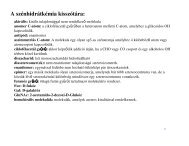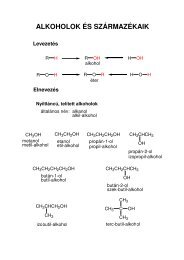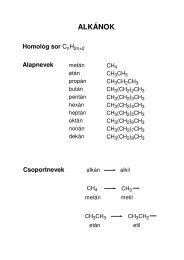13.4 UV/VIS Spectroscopy The spectroscopy which utilizes the ...
13.4 UV/VIS Spectroscopy The spectroscopy which utilizes the ...
13.4 UV/VIS Spectroscopy The spectroscopy which utilizes the ...
Create successful ePaper yourself
Turn your PDF publications into a flip-book with our unique Google optimized e-Paper software.
<strong>13.4</strong> <strong>UV</strong>/<strong>VIS</strong> <strong>Spectroscopy</strong><br />
<strong>The</strong> <strong>spectroscopy</strong> <strong>which</strong> <strong>utilizes</strong> <strong>the</strong> ultraviolet (<strong>UV</strong>) and visible (<strong>VIS</strong>) range of electromagnetic<br />
radiation, is frequently referred to as Electronic <strong>Spectroscopy</strong>. <strong>The</strong> term implies that <strong>the</strong>se<br />
relatively high energy photons disturb <strong>the</strong> electron distribution within <strong>the</strong> molecule.<br />
Consequently, <strong>the</strong> MO description of <strong>the</strong> molecular electron distribution and its change during<br />
excitations is very useful.<br />
<strong>13.4</strong>.1 <strong>The</strong> orbital basis of electronic <strong>spectroscopy</strong><br />
In general, we may distinguish two (2) bonding type MO (σ and π), one (1) non-bonding type (n)<br />
lone pair MO, and two (2) anti-bonding type MO (σ* and π*). This scheme is illustrated by<br />
Figure 13.34.<br />
Figure 13.34 A schematic illustration of six (6) transitions between three (3) types of occupied<br />
and two (2) types of unoccupied MO.<br />
Depending on <strong>the</strong> extent of conjugative interactions, <strong>the</strong>se transitions may fall anywhere within<br />
<strong>the</strong> three well recognized segments of <strong>the</strong> spectrum.<br />
Table 13.5 Ranges of <strong>the</strong> electromagnetic radiation used in electronic <strong>spectroscopy</strong>.<br />
Radiation λ ν*<br />
nm Å cm -1<br />
<strong>VIS</strong> 400-750 4000-7500 25000-13000<br />
near <strong>UV</strong> 200-400 2000-4000 50000-25000<br />
far <strong>UV</strong> a)
observed: <strong>the</strong> low energy (long wavelength) n →π∗ and <strong>the</strong> higher energy (shorter wavelength)<br />
π→π∗ as illustrated by Figure 13.35.<br />
Figure 13.35 A typical electronic spectrum of a carbonyl compound.<br />
<strong>The</strong> intensity of <strong>the</strong> absorption is measured by <strong>the</strong> molar extinction coefficient (ε) and it is defined<br />
in terms of <strong>the</strong> incidental (Io) and transmitted (I) light intensity, as well as <strong>the</strong> concentration of <strong>the</strong><br />
solution (c) and <strong>the</strong> path length (l).<br />
1<br />
ε =<br />
cl<br />
log10<br />
<strong>The</strong> value of ε may be within a large range of values<br />
when c = 1 mol/L and l = 1cm.<br />
0 ≤ ε ≤ 10 6<br />
I<br />
I<br />
0<br />
[13.34a]<br />
[13.34b]<br />
<strong>The</strong> greater <strong>the</strong> ε value, <strong>the</strong> more probable <strong>the</strong> absorption. In general, <strong>the</strong> n→π∗ absorption is<br />
practically “symmetry forbidden” or “overlap forbidden” because <strong>the</strong> electron is promoted from<br />
<strong>the</strong> plane of <strong>the</strong> molecule to a plane <strong>which</strong> is perpendicular to <strong>the</strong> molecular plane. This is not <strong>the</strong><br />
case for <strong>the</strong> π→π∗ excitation and <strong>the</strong>refore, it is an allowed transition, and consequently, more<br />
intense.
Figure 13.36 A schematic illustration of <strong>the</strong> spatial arrangement of <strong>the</strong> two lobes of <strong>the</strong> lone pair n<br />
(<strong>which</strong> is like a 2py of oxygen) and <strong>the</strong> four lobes (two + and two -) of <strong>the</strong> π∗ MO or a carbonyl<br />
functional group.<br />
<strong>The</strong> wavelength (or wavenumber) depends on <strong>the</strong> extent of conjugation. This is illustrated by <strong>the</strong><br />
data summarized in Table 13.6 and <strong>the</strong> underlying principle is shown in Figure 13.37.<br />
Table 13.6 Carbonyl transitions as <strong>the</strong> function of conjugative interaction.<br />
Functional group strong<br />
π→π*<br />
λmax (nm)<br />
weak<br />
n→π*<br />
C=O 166 280<br />
C=C−C=O 240 320<br />
C=C−C=C−C=O 270 350<br />
This change in absorption, due to conjugative interaction, is true not only for carbonyl compounds<br />
but unsaturated hydrocarbons as well (c.f. Table 13.7). Of course in this latter case no n→π∗<br />
transitions are allowed. Only π→π∗ transitions are possible since <strong>the</strong> molecule contains no lone<br />
pair (n).
Table 13.7 <strong>The</strong> effect of conjugative interaction on <strong>the</strong> π→π∗ electronic transitions of unsaturated<br />
hydrocarbons.<br />
π→π*<br />
Functional group λmax (nm) ε<br />
C=C 170 16000<br />
C=C−C=C 220 21000<br />
C=C−C=C−C=C 260 35000<br />
<strong>The</strong> wavelengths shift towards larger λ values i.e. towards <strong>the</strong> red (“red-shift”) with conjugative<br />
interaction. Of course, in agreement with [13.1], wavelengths mean smaller wave numbers and<br />
<strong>the</strong>refore lower excitation energy [13.35]:<br />
ν*<br />
=<br />
λ<br />
1<br />
1<br />
∆E = hcν* = hc<br />
λ<br />
[13.35a]<br />
[13.35b]<br />
An explanation for <strong>the</strong> above phenomena may conveniently be given in terms of MO levels. This<br />
is illustrated for an unconjugated carbon-carbon double bond in Figure 8.2 and for a nonconjugated<br />
carbonyl in Figure 6.18. <strong>The</strong> effect of conjugative interaction for C=C−C=C can be<br />
demonstrated in terms of <strong>the</strong> MO level diagrams of two ethylene molecules (c.f. Figure 13.37).<br />
Figure 13.37 MO level correlation diagram to illustrate <strong>the</strong> effect of conjugation on <strong>the</strong> π→π∗<br />
transition of unsaturated hydrocarbons.
Clearly <strong>the</strong> π→π∗ excitation energy for <strong>the</strong> conjugated pair of double bonds, ∆E2(π→π∗), is<br />
smaller than <strong>the</strong> excitation energy for a single, unconjugated double bond, ∆Ε1(π→π∗). <strong>The</strong><br />
former one has a longer wavelength absorption in comparison to <strong>the</strong> latter one.<br />
∆Ε2(π→π∗) < ∆Ε1(π→π∗)<br />
λ (2) max (π→π∗) > λ (1) max (π→π∗)<br />
[13.36a]<br />
[13.36b]<br />
More extensive conjugative interaction exists in <strong>the</strong> conjugated hexatriene (<strong>the</strong> last entry in Table<br />
13.7). This can be demonstrated, analogously to that of <strong>the</strong> situation presented in Figure 13.37, in<br />
terms an MO correlation diagram involving a butadiene (C=C−C=C) and an ethylene (C=C)<br />
molecule.<br />
<strong>The</strong> effect of conjugative interaction for C=C−C=O can be illustrated in terms of MO level<br />
diagrams for an ethylene and a formaldehyde molecule (c.f. Figure 13.38).<br />
Figure 13.38 MO level correlation diagram to illustrate <strong>the</strong> effect of conjugation on <strong>the</strong> n→π∗ and<br />
π→π∗ transition of unsaturated carbonyl compounds.
In <strong>the</strong> first approximation shown in Figure 13.38, we can assume that <strong>the</strong> non-bonded (n) lone pair<br />
is not affected by conjugation and, <strong>the</strong>refore its energy value is unchanged. However, <strong>the</strong> π and<br />
π∗ levels do change. This influences <strong>the</strong> transition, promotion or excitation energies, and,<br />
<strong>the</strong>refore, <strong>the</strong> wavelength, of both <strong>the</strong> n→π∗ and <strong>the</strong> π→π∗ modes of excitation. As a result, we<br />
may recognize <strong>the</strong> following inequalities:<br />
E2(n→π∗) < E1(n→π∗) [13.37a]<br />
E2(π→π∗) < E1(π→π∗) C = C C = O<br />
≈ E1(π→π∗)<br />
320<br />
[13.37b]<br />
More extensive conjugative interaction, <strong>which</strong> exists in C=C−C=C−C=O (c.f. last entry in Table<br />
13.6) can be demonstrated, using butadiene and formaldehyde as components.<br />
<strong>13.4</strong>.2 Spectral shift upon protonation<br />
<strong>The</strong> various functional groups, <strong>which</strong> are involved in <strong>the</strong> determination and/or modification of<br />
electronic spectral characteristics, are frequently referred to as chromophores. <strong>The</strong> C = C and<br />
C =O functionalities, <strong>which</strong> previously discussed, are also chromophores. However, <strong>the</strong>re are<br />
o<strong>the</strong>r functionalities, <strong>which</strong> can be regarded as chromophores. Two such groups, <strong>which</strong> can<br />
exhibit both n→π∗ and π→π∗ excitations, are <strong>the</strong> imine and <strong>the</strong> azo groups.<br />
C N N N<br />
imine azo<br />
[13.38]<br />
Whenever lone pair (n)-containing heteroatoms are part of a double-bonded system, <strong>the</strong>y may<br />
undergo protonation under acidic conditions.
(a) (b) (c)<br />
n n<br />
C O C N N N<br />
H (+)<br />
H (+)<br />
C O C N N N<br />
321<br />
H (+)<br />
H H H<br />
(+)<br />
(+) (+)<br />
n<br />
(a) (b) (c)<br />
n<br />
n<br />
[13.39]<br />
[<strong>13.4</strong>0]<br />
As <strong>the</strong> result of protonation, <strong>the</strong> lone pair (n) becomes a bonding pair (σ). Fur<strong>the</strong>rmore, all<br />
electrons are now held more tightly and so all MO energy levels are lowered. Interestingly<br />
enough, <strong>the</strong> LUMO is also lowered substantially as shown by Figure 13.39.
Figure 13.39 Spectral red shift of π→π∗ transition upon protonation.<br />
322
What is shown in Figure 13.39 is <strong>the</strong> basis of a whole class of acid-base indicators, <strong>which</strong> show a<br />
red shift upon protonation. <strong>The</strong> two classic examples are Methyl orange (discovered by Griess in<br />
1877) and Methyl red (syn<strong>the</strong>sized by Rupp in 1908). <strong>The</strong>se are amphoteric azo-dyes <strong>which</strong> are<br />
soluble in both acids and bases [<strong>13.4</strong>1].<br />
O O<br />
Na (+)<br />
(-)<br />
S<br />
O<br />
N N<br />
methylorange<br />
(a)<br />
Me<br />
N<br />
Me<br />
Na (+)<br />
(-)<br />
O C<br />
323<br />
O<br />
N N<br />
methylred<br />
(b)<br />
Me<br />
N<br />
Me<br />
[<strong>13.4</strong>1]<br />
Under acidic conditions, it is not only organic acids liberated from <strong>the</strong>ir sodium salts <strong>which</strong> are<br />
protonated but also one of <strong>the</strong> two lone pairs of <strong>the</strong> -N=N- functional group. It appears that <strong>the</strong> N<br />
on <strong>the</strong> left hand side is more basic than <strong>the</strong> N on <strong>the</strong> right hand side because <strong>the</strong> NMe2 group<br />
conjugatively stabilizes <strong>the</strong> protonated azo-dye type indicator, [<strong>13.4</strong>2].<br />
N N<br />
Me<br />
N<br />
Me<br />
Ar Ar<br />
neutral (or alkaline)<br />
solution<br />
(yellow)<br />
+ H (+)<br />
+ H (-)<br />
H<br />
N N<br />
Me (+)<br />
N Me<br />
acidic<br />
solution<br />
(red)<br />
<strong>13.4</strong>.3 Electron configuration and multiplicities of ground and excited states<br />
[<strong>13.4</strong>2]
It was implied in Figures 13.34, 13.37 and 13.38 that <strong>the</strong> energy of <strong>the</strong> <strong>VIS</strong> or <strong>UV</strong> radiation is<br />
used for <strong>the</strong> promotion of an electron when an excitation occurs. Thus, in electronic <strong>spectroscopy</strong><br />
we are essentially changing <strong>the</strong> ground state electronic configuration to one of <strong>the</strong> excited state<br />
electron configurations. <strong>The</strong> n→π∗ and π→π∗ excitations of a C=O functionality, are shown in<br />
Figure <strong>13.4</strong>0.<br />
all<br />
electrons<br />
= =1<br />
S s i<br />
i<br />
324
325<br />
[<strong>13.4</strong>3]<br />
Figure <strong>13.4</strong>0 Ground and low-lying excited state electron configurations of a carbonyl function<br />
group.<br />
Note that in this figure <strong>the</strong> spin state is conserved, because in both <strong>the</strong> electronic ground state and<br />
<strong>the</strong> electronic excited state, we have <strong>the</strong> same number of α spins (s=+½) and β spins (s=- ½).<br />
Consequently, <strong>the</strong> net or overall spin state (S), <strong>which</strong> is <strong>the</strong> sum of <strong>the</strong> individual spins (si), will<br />
add up to zero.<br />
<strong>The</strong>refore, we may introduce <strong>the</strong> concept of multiplicity (m) to characterize <strong>the</strong> Spin State of <strong>the</strong><br />
molecular electron distribution:<br />
m = 2⏐S⏐+1<br />
[<strong>13.4</strong>4]<br />
In <strong>the</strong> low-lying excited state electron configurations presented in Figure <strong>13.4</strong>0, <strong>the</strong> total or overall<br />
spin was zero and <strong>the</strong>refore, <strong>the</strong> multiplicity was found to be 1, <strong>which</strong> is called a singlet:<br />
S = 0 [<strong>13.4</strong>5a]<br />
m = 1 (Singlet) [<strong>13.4</strong>5b]
Practically all organic molecules have singlet multiplicities in <strong>the</strong>ir electronic ground state due to<br />
<strong>the</strong> double occupancy of <strong>the</strong> MO energy levels. In contrast, free radicals, such as those discussed<br />
in Chapter 9, have half integer spins (i.e. + ½ or -½) and <strong>the</strong>refore, have doublet multiplicity<br />
([<strong>13.4</strong>6] and Figure <strong>13.4</strong>1)<br />
S = ±½ [<strong>13.4</strong>6a]<br />
m = 2 | ½ | + 1 = 2 (Dublet) [<strong>13.4</strong>6b]<br />
Figure <strong>13.4</strong>1 Doublet spin states for an odd number electron-containing chemical system<br />
(e.g. Li).<br />
<strong>The</strong> two spin states can be described by two wave functions, <strong>which</strong> yield identical energy values<br />
(double degeneracy) in <strong>the</strong> absence of a magnetic field. However, <strong>the</strong>ir energy values will differ<br />
from each o<strong>the</strong>r in <strong>the</strong> presence of an external magnetic field. This leads to an energy level<br />
diagram (Figure <strong>13.4</strong>2) is analogous to that in Figure 13.2. However, in <strong>the</strong> present case, it is<br />
electron spin not nuclear spin, <strong>which</strong> makes <strong>the</strong> difference.<br />
326
Figure <strong>13.4</strong>2 Variation of a free radical electron Spin State (α or β) energy with external magnetic<br />
field (Bo).<br />
This leads to electron spin resonance (ESR) <strong>spectroscopy</strong>, <strong>which</strong> will not be discussed fur<strong>the</strong>r in<br />
<strong>the</strong>se lecture notes.<br />
Returning to <strong>the</strong> principles of excited configurations generated from closed electronic shell ground<br />
states (characterized by double occupancy) presented in Figure <strong>13.4</strong>0, we may recognize <strong>the</strong><br />
possibility of spin flips. Consequently, we may have two identical spin states (αα or ββ), in<br />
addition to αβ, giving rise to triplet multiplicity [<strong>13.4</strong>7]:<br />
S = Sαα = + ½ + ½ = + 1 [<strong>13.4</strong>7a]<br />
S = Sββ = -½ - ½ = -1 [<strong>13.4</strong>7b]<br />
m = 2 S + 1 = 2 x 1 + 1 = 3 (Triplet) [<strong>13.4</strong>7c]<br />
<strong>The</strong> electron configuration for <strong>the</strong> Sαα spin states, associated with <strong>the</strong> n→π∗ and π→π∗ modes of<br />
excitations, are illustrated in Figure <strong>13.4</strong>3. Figure <strong>13.4</strong>3 is an extension of Figure <strong>13.4</strong>0.<br />
327
Figure <strong>13.4</strong>3 Singlet and triplet electron configurations of a carbonyl group.<br />
<strong>13.4</strong>.4 Potential energy curves of ground and excited states<br />
Energy is always a function of molecular geometry, a concept, <strong>which</strong> we have presented many<br />
times before. Conformational potential energy curves (PEC) and potential energy surfaces (PES)<br />
were covered extensively in Chapters 4 and 5. For stretching potentials, <strong>the</strong> first example was<br />
seen in Figure 1.7 and <strong>the</strong> last example was given in this chapter in Figure 13.33.<br />
All of <strong>the</strong> above were related to <strong>the</strong> electronic ground states of <strong>the</strong> molecular systems in question.<br />
It should not be surprising to learn that <strong>the</strong> same may be applied for electronic excited states.<br />
However, <strong>the</strong>re are some differences that are observed when comparing <strong>the</strong> details of <strong>the</strong> excited<br />
PEC or PES with <strong>the</strong>ir ground state counterparts. Take for example, a simple carbonyl compound<br />
such as formaldehyde (H2C=O). In <strong>the</strong> n→π∗ excited state an electron arrives at <strong>the</strong> antibonding π<br />
orbital, while <strong>the</strong> electron pair in <strong>the</strong> bonding π orbital is still present. Due to <strong>the</strong> third antibonding<br />
π electron, <strong>the</strong> C=O bond becomes weaker and longer. In <strong>the</strong> π→π∗ excited<br />
configuration, <strong>the</strong> situation is somewhat worse because <strong>the</strong>re is only one π electron in <strong>the</strong> bonding<br />
orbital, while <strong>the</strong> o<strong>the</strong>r π electron is anti-bonding (i.e. π∗). Consequently, <strong>the</strong> excited state bond<br />
328
lengths will be longer than a genuine C=O double bond but shorter than a σ-type single C−O<br />
bond. In o<strong>the</strong>r words, <strong>the</strong>se excited states will have <strong>the</strong>ir energy minima somewhere in between<br />
that of H2C=O and H3C−OH. This principle is illustrated schematically in Figure <strong>13.4</strong>4. <strong>The</strong><br />
figure also illustrates <strong>the</strong> fact that all energy curves have vibrational levels (just like that given in<br />
Figure 13.33) even though only two (<strong>the</strong> 0 and 1) are specified explicitly in Figure <strong>13.4</strong>4. Note<br />
that <strong>the</strong> bottom of <strong>the</strong> TRIPLET state curve is lower than <strong>the</strong> bottom of <strong>the</strong> SINGLET state curve.<br />
This may be regarded as a consequence of <strong>the</strong> generalized Hund’s rule.<br />
Figure <strong>13.4</strong>4 Morse type stretching potentials for <strong>the</strong> low lying electronic states of a typical<br />
carbonyl compound.<br />
329
<strong>The</strong> spin momentum conservation rule dictates that a transition will occur between <strong>the</strong> singlet<br />
ground state and one of <strong>the</strong> singlet excited states. Transition from a singlet to a triplet is<br />
forbidden. However, intersystem crossing from <strong>the</strong> excited singlet state to <strong>the</strong> corresponding<br />
excited triplet state De-excitation or relaxation back to <strong>the</strong> ground state may take place with<br />
simultaneous radiation. When de-excitation originates in <strong>the</strong> excited Singlet State, it is called<br />
fluorescence (F). When relaxation begins at <strong>the</strong> excited Triplet State, <strong>the</strong> process is called<br />
phosphorescence (P). <strong>The</strong> frequencies of <strong>the</strong>se two modes of de-excitation (i.e. F and P) <strong>which</strong><br />
correspond to <strong>the</strong> energy released, are smaller than <strong>the</strong> frequency and corresponding energy of <strong>the</strong><br />
absorption (A) or excitation [<strong>13.4</strong>8]:<br />
<strong>The</strong>se points are illustrated schematically in Figure <strong>13.4</strong>5.<br />
νA > νF > νP [<strong>13.4</strong>8a]<br />
∆EA > ∆ΕF > ∆ΕP [<strong>13.4</strong>8b]<br />
λA < λF < λP [<strong>13.4</strong>8c]<br />
Figure <strong>13.4</strong>5 A schematic illustration of absorption (A) fluorescence (F) and phosphorescence (P)<br />
of a typical organic compound.<br />
<strong>The</strong> absorption process is more complicated than Figure <strong>13.4</strong>5 might reveal. Before <strong>the</strong>y are<br />
excited, most ground state molecules occupy <strong>the</strong>ir zero point vibrational (ZPV) level. However,<br />
330
<strong>the</strong> excited molecules may occupy any of <strong>the</strong> vibrational levels associated with <strong>the</strong> same<br />
geometry. <strong>The</strong>re are two special cases however,<br />
(i) <strong>the</strong> vertical (or Frank-Condon) excitation<br />
(ii) <strong>the</strong> 0 - 0’ (or adiabatic) excitation<br />
(iii)<br />
However, <strong>the</strong> possibility of <strong>the</strong> involvement of any vibrational levels in transitions, leads to a<br />
vibrational structure of <strong>the</strong> absorption spectrum. <strong>The</strong>se principles are illustrated in Figure <strong>13.4</strong>6.<br />
Figure <strong>13.4</strong>6 Vertical and adiabatic transitions as well as <strong>the</strong> vibrational structure associated with<br />
an absorption spectrum (left hand side, side-ways). <strong>The</strong> IR transition of <strong>the</strong> ground electronic<br />
state is also marked in at 1700 cm -1 .<br />
In this figure <strong>the</strong> spectrum is presented side-ways at <strong>the</strong> left-hand side. <strong>The</strong> vertical (or Frank-<br />
Condon) transition is usually <strong>the</strong> most intense vibrational peak corresponding to λmax (c.f. Figure<br />
13.35). <strong>The</strong> weakest low energy section (i.e. <strong>the</strong> tail end in Figure 13.35) is where <strong>the</strong> 0 - 0’ (or<br />
adiabatic) transition is located. When no vibrational structure is found, <strong>the</strong> maximum (i.e. λmax)<br />
still corresponds to <strong>the</strong> vertical transition.<br />
One of <strong>the</strong> most ordinary compounds with a vibrational structure in its <strong>UV</strong> absorption<br />
spectrum is benzene (c.f. Figure <strong>13.4</strong>7).<br />
331
Figure <strong>13.4</strong>7 <strong>UV</strong> spectrum of benzene showing <strong>the</strong> molecular vibrational structure.<br />
Carbonyl compounds do not often show vibrational structure. However, under certain<br />
circumstances, with appropriate substitution for X in X−C=O, <strong>the</strong> n→π∗ transitions have sharp<br />
vibrational structures. In this case, <strong>the</strong> vibrational spacing is much less than 1600 or 1700cm -1 ,<br />
<strong>which</strong> is <strong>the</strong> typical ground state C=O stretch and a little bit larger than <strong>the</strong> characteristic<br />
frequency of <strong>the</strong> C−O stretch (1000 - 1100cm -1 ). Thus, <strong>the</strong> spacing between <strong>the</strong> vibrational peaks<br />
corresponds to <strong>the</strong> vibrational levels of <strong>the</strong> particular excited state and in this state <strong>the</strong> CO bond is<br />
located somewhere in between a single and a double bond (c.f. Figure <strong>13.4</strong>8).<br />
332
Figure <strong>13.4</strong>8 Carbonyl n→π∗ transitions for selected compounds of <strong>the</strong> type Ph3X−CO−Ph<br />
<strong>The</strong> upper left hand side of Figure <strong>13.4</strong>8 shows that <strong>the</strong> heavy atom substitution (i.e. C → Si or C<br />
→ Ge)<br />
(i) shifts <strong>the</strong> absorption frequency (ν∗) towards <strong>the</strong> visible (red-shift) and <strong>the</strong> compounds<br />
become colored (note: 25,000cm -1 = 400nm)<br />
(ii) accentuates <strong>the</strong> vibrational structure <strong>which</strong> was hardly noticeable in Ph3COPh<br />
<strong>The</strong> lower left hand side of Figure <strong>13.4</strong>8 shows that <strong>the</strong> observed envelope curves, for X = Si and<br />
Ge, of <strong>the</strong> spectra, showing partially resolved vibrational fine structures, may be deconvoluted to<br />
Gaussian components. <strong>The</strong>se Gaussian components are representing <strong>the</strong> transitions to individual<br />
vibrational levels of <strong>the</strong> n→π∗ excited states. <strong>The</strong> characteristic values of <strong>the</strong>se vibrational bands<br />
are summarized in Table 13.8.<br />
<strong>The</strong> right hand side of Figure <strong>13.4</strong>8 provides an explanation of <strong>the</strong> red shift in terms of d-orbital<br />
participation of <strong>the</strong> heavy atom (X = Si, Ge). Combining for example, <strong>the</strong> C=O with Si to<br />
produce a Si−C=O system, leads to a small increase in all three C=O levels because <strong>the</strong> inductive<br />
effect of Si is followed by a splitting of <strong>the</strong> π - levels as <strong>the</strong>y interact with a vacant d-orbital on Si.<br />
Table 13.8 Results of resolution of n →π∗ bands of triphenylsilyl phenyl and triphenylgermyl<br />
phenyl ketones into gaussian components<br />
333
Assigned<br />
transition<br />
Peak position<br />
ν*<br />
(cm -1 )<br />
334<br />
Molar extinction<br />
coefficient<br />
Triphenylsilyl phenyl ketone<br />
0→0 1 22.350 168<br />
Vibrational spacing<br />
∆ν*<br />
(cm -1 )<br />
0→1 1 23.540 285 1190 a)<br />
0→2 1 24.00 195 1160<br />
0→3 1 25.740 106 1040<br />
0→4 1 26.730 35 990<br />
Triphenylgermyl phenyl ketone<br />
0→0 1 22.660 133<br />
0→1 1 23.880 246 1220 a)<br />
0→2 1 25.080 180 1000<br />
0→3 1 26.210 100 1130<br />
0→4 1 27.260 40 1050<br />
a) Fundamental vibrational frequency of <strong>the</strong> n→π* electronic excited state<br />
<strong>13.4</strong>.5 Cis-trans isomerization and photochemistry<br />
<strong>The</strong> potential energy curve for a <strong>the</strong>rmal cis-trans isomerization was presented earlier (c.f. Figure<br />
8.1). Photochemical isomerization also involves excited state conformational potential energy<br />
curves as well. In most cases <strong>the</strong> excited state potential energy curves are in different phases with<br />
respect to <strong>the</strong> ground state. This is due to <strong>the</strong> fact that <strong>the</strong> minimum energy conformers of <strong>the</strong><br />
excited states are different from that of <strong>the</strong> ground state. In <strong>the</strong> case of an olefinic double bond <strong>the</strong><br />
excited state conformation is not planar but twisted out of plane by 90°.
Figure <strong>13.4</strong>9 Twisted geometry of singlet and triplet excited ethylene.<br />
<strong>The</strong> schematic potential energy curves for <strong>the</strong> ground and excited states of 1,2-disubstituted<br />
ethylene are shown in Figure 13.50.<br />
335
Figure 13.50 A schematic illustration of a photochemical cis-trans isomerization.<br />
<strong>The</strong> photochemistry of vision is related to cis-trans isomerization. A molecule called rhodopsin,<br />
<strong>which</strong> is made up of 11-cis-retinal and a protein called opsin, undergoes cis-trans isomerization<br />
upon radiation with visible light [<strong>13.4</strong>9].<br />
336
Me<br />
Me<br />
Me<br />
Me<br />
Me<br />
Me<br />
Me<br />
11 12<br />
Me C<br />
hν<br />
Me<br />
13<br />
Me<br />
337<br />
(11 - cis)<br />
N<br />
(all trans)<br />
Protein<br />
Me Protein<br />
During <strong>the</strong> past half a century, a great deal has been discovered about photochemical reactions.<br />
Clearly, in addition to vision, photochemistry is of great importance in nature because<br />
photosyn<strong>the</strong>sis in plants is based on <strong>the</strong> harnessing of <strong>the</strong> energy of sunlight. As it turns out,<br />
laboratory experiments have demonstrated that one can achieve many reactions photochemically,<br />
<strong>which</strong> do not proceed <strong>the</strong>rmally. However important <strong>the</strong>se photochemical reactions may be, <strong>the</strong>y<br />
will not be discussed in <strong>the</strong>se lecture notes at this time.








